A Tale of the Present PRINTRBOTe (Part 1: Musa Isaakovna)
There is no truth in the legs. /BUT. Maresyev /

Printrbot'y (hereinafter PB) - rare guests on Habré, and indeed, in the press about them write a little.
Although the Brook Drumm affair (Brook Drumm) lives and thrives in its homeland.
I suppose what the printer pushes away the European dealers, so he drew me, namely:
Next, we will discuss one of the representatives of the PB - Printrbot Jr , in Kit's version for assembly, together with an additional desktop upgrade with heating - Heated Bed Upgrade , for printing with ABS plastic.
Now this printer has been purchased, assembled, calibrated and is working hard on my desk, printing toys for the New Year.
I want to describe the fate of this exhibit from the very beginnings, from the very idea to its immediate application, since this fate was not easy and closely intertwined with mine, sometimes first leading to complete psychological exhaustion, and then sharply stunning the Wow effect.
Initially, three parts were conceived: From the idea to the acquisition of Kit; Assembly and setup of the printer; From toys to practical use. But in the process of writing, I decided to include everything in one article with an emphasis on assembly and configuration.
As a result, I recommend this material as an extremely useful addition to the original and only step-by-step assembly instruction , which is extremely superficial, ambiguous and leaves much to be desired.
Looking ahead, I’ll say that this 3D printer was worth the trouble), which distinguishes it from many of its fellows, and more on that in order.
The more articles about household-home 3D printers, the more I wanted to buy one. But the price is from 50-60 tr. did not allow the dream to come true, since the investments in the toy were obviously overstated. Why in a toy? Because even now the practical application of a home-based 3D printer is not very clear. But about this, too, a little later.
')
The RepRap project, for which Muse Isaakovna organized close monitoring, was and remains a panacea that allows any technically savvy amateur to assemble their own 3D printer at a more or less reasonable price and quite acceptable quality. Accuracy of the press 0.1 mm provides practically any household needs. But watching the development of the project all the time there was a feeling of some kind of dampness of the structure ... until independent directions began to sprout from the project. Departing from the ideology of true RepRap, which, if possible, prints most of the details for itself, new projects began to take the best practices of RepRap and discard imperfect self-printed designs, which were replaced by similar ones, but from a different material or fundamentally new ones.
So MakerBot and many of its clones "in the box" appeared. The era of monetization of 3D printers and consumer 3D printing has begun. But the price for the final product was still too high, especially for a housewife and with still not quite specific formulation of home use. It was necessary to simplify.
And so Cube appeared, and naturally its “followers” . And they came cartridges! The main source of earnings for printer manufacturers. To close the uncertainty with the use of steel began to create a database of 3D-models .
"And everything seems to be as usual, and it seems like to live, do not hurt."
But the price ... 500-700 USD, it still was not something that I would like to spend on a toy for the soul. And again, how to explain such expenses to the wife ...
Muse Isaakov frowned unpleasantly but continued to demand to remind herself of herself.
You ask then, why not put together the original RepRap, if you really want to? I will answer once again - for a shrewd design engineer, all RepRap models are literally teeming with controversial and not quite effective technical solutions. I will emphasize - namely, technical solutions, i.e. the design of the truss, drives, extruder, etc. Because I have no complaints about any electronic circuit board of brains and firmware, this is a controller for 4-5 step motors, three limit switches, 1-2 heaters and 1-2 thermistors, understanding G -code. This is all about the same and is based on the Arduino. And the software part is able to withstand accuracy and 0.01 mm, but is the hardware capable? Is the mechanic able to provide the specified accuracy and smoothness of movements?
The classic RepRap'a is not exactly in trouble, but due to the triangular-square truss from round axes in plastic brackets, even if it is reinforced with a U-shaped truss in recent versions ... well, it’s not aesthetically pleasing. Not a lunar rover. "Saw Fedya, saw!" (C)
The bottom line: RepRap is a fine, but experimental laboratory; 3D printers a la MakerBot - still indecent road; UP! Plus and others like Cube with them - they print thickly and tend to original cartridges! which my inner self does not accept genetically, and even in the presence of several successful projects of mini-factories for the production of recycled bars.
But here flashed in the press Printrbot.
And on Habré flashed .
Here I want to immediately make a reservation that this is not PR or advertising. This is a story about a printer that is fundamentally unlike all others. Hence to him my tremulous love and attention. And as a result, the printer showed itself from the best side and met the expectations that had been placed, though it was traumatic and psychologically traumatic several times. And this is a tribute to the deep respect for the talents of Brooke Drumm, who has an outstanding appearance and dedication, who turned his hobby into a successful business. Which formulated his concept of home 3D-printer, which coincides with the opinion of the author, and relentlessly follows it.

Brooke Drumm with his creations.
Plywood ... wood in 3D printing! It was a steampunk, or woodpunk, I don’t know what’s best.
The live Soviet coat of arms is quick, like a blow with a hammer, and sharp, like a sickle in the balls. (WITH)
After close examination, the following were noted:
But that moment the Junior Whale Set cost 399 USD on the manufacturer's website. After the appearance of the Simple whale for 299 USD, the junior whale was, unfortunately, removed from production.
Muse Isaakov stared from the reflection of the monitor, straightened the cardigan, pressed the massive chest in Raikin's and exhaled - We must take it!
I said - I obey! - and ran to the Internet.
It was not so easy to write “shoe polish” from the American “uncle”. Rather, there were no problems with the ordering, even to a Moscow address, but with payment ...
Printrbot turned out to be a small company, frankly home. And its not less small, unknown bank at the border of the United States and Canada flatly refused to accept payment from a citizen of the Russian Federation. He refused to accept from the ruble account, from the currency account and even from the PayPal resident of the Russian Federation. The latter introduced in some stupor, since when did PayPal become sensitive to citizenship ?! But Musa Isaakovna was the only attendeer of heart issues, but she was silent, and only demandingly and intently allowed mental fluids.
Next, I planned to devote a separate part of the article to the method of purchases from the states. But, having a keen desire to quickly move on to the assembly, I will limit myself to a brief summary, especially on the very topic of such purchases written and so much and in individual articles.
As a result, the following combination was played.
Registered account in Shipito .
Pre-paid photos of the contents of parcels in face, profile and in parts.
The address of the “transit point” in the United States in the duty-free zone is selected: Tualatin, Oregon .
All possible supporting documents were sent to improve the status of the account, in order to avoid problems and delays in payment and sending parcels:
All this was enough to get the status of checking 70% and enter the green zone of trusted-trusted clients.
If you additionally send the form 1583 in the original and notarized, you will have 110% verification, yellow pants and three times Ku!
Further, the Tualatin city was specified on the PB website at the delivery address, which is in the state of Oregon and ... And payment from the ruble card through PayPal went smoothly.
After a couple of days, the package arrived in Tualatin, and a dozen of pretty photos appeared in Shipito’s personal account.
Some of them:
one

2

3
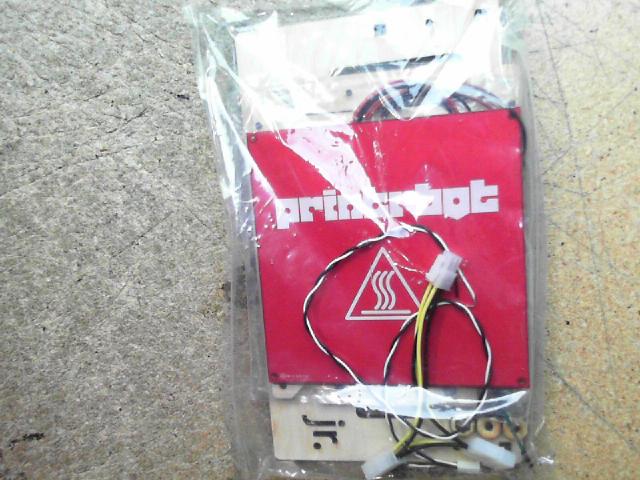
four
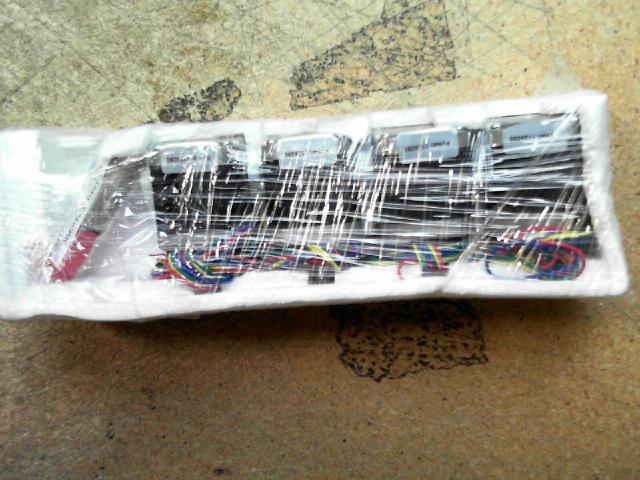
five
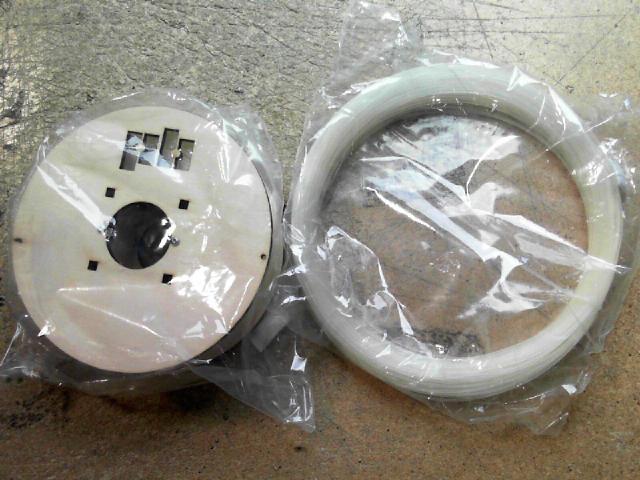
6
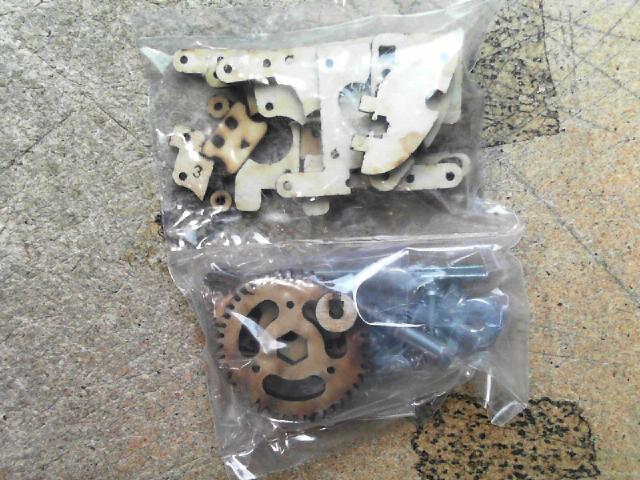
7
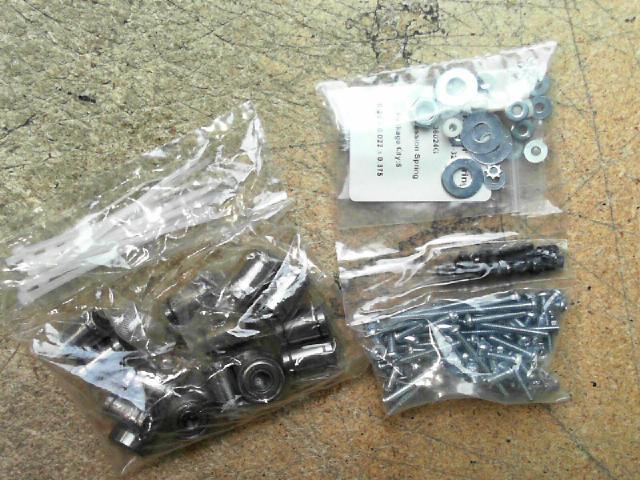
At the insistence of the Shipito website, I had already filled out the customs declaration before the parcel arrived, honestly listing all items and prices, on the basis of an invoice from the PB shop. The parcel status was assigned, of course, Gift - a gift, that is, not for resale. The delivery address in Moscow was also entered in the personal account and selected for default deliveries.
On the recommendation of this article , the delivery method and the insurance options for it were chosen:
USPS Express Mail
Insurance: Delivery + Damage
As shown, in no case do not save on shipping and insurance, within reasonable limits of course. With the chosen method of delivery, the parcel was handed from hand to hand, in a pre-agreed time interval, by a very, very tidy courier EMS Russian Post. The truth is not on time ...
As a result, it only remains for me to confirm the quality of the photos and the contents, confirm the delivery method, transfer the amount necessary for the calculation to the Shipito account, and the printer immediately went to the previously entered address.
To Moscow, comrades, to Moscow! (WITH)
Immediately after the shipment from Shipito, the parcel was assigned an ID-number tracker by which the fate of the shipment could be tracked on the USPS website until it entered the EMS.
A week later, the cargo had already arrived in Russia, lay for a couple of days at customs, was missed and disappeared into the EMS.
A month later, a very polite operator called me and agreed on the time and place of delivery of the precious cargo. And, as I wrote earlier, the cargo was delivered intact, “on time” and passed from hand to hand with a dazzling smile.
Muse Isaakovna exulted.
About a month has passed from the moment I received the parcel before I started assembling the dream unit.
During this time, Musa Isaakovna managed to gain a few extra pounds, ring out in breadth and noticeably rounded, and I managed to acquire some additional tools for assembly, such as a ratchet clamp, a mallet, PVA glue, and a wood burner.
And now the hour X has come. The instructions from the site were printed, the box was opened and the process began.
As I said earlier, this material is a useful addition to the main printer assembly instructions.
And there is.
And before the next follower starts to assemble the wonderful Printrbot Jr on his own, I will give some background information, which it is extremely useful to learn without fail before starting the assembly, in order to understand and understand exactly what you received in the cherished box. This will help protect you from a lot of annoying blunders that the author tragically experienced.
To understand the essence of the problem you need to refer to the device of the laser cutting machine.
In essence, this is the same coordinate printer, only instead of an extruder - a laser cutter. More precisely, the CO2 laser lamp is located somewhere immobile in a protective casing, and the laser beam itself is focused by a lens and transmitted to the treated surface by a system of movable mirrors.
Schematic diagram of a laser cutting machine
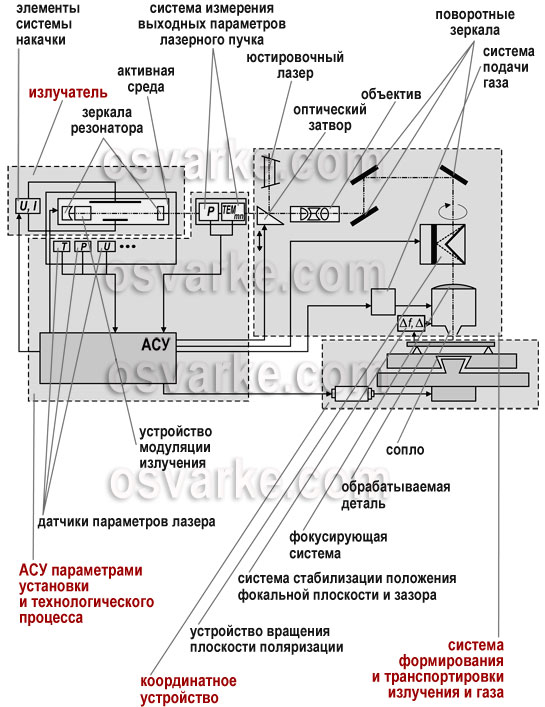
The scheme of the laser machine for cutting sheet wood materials
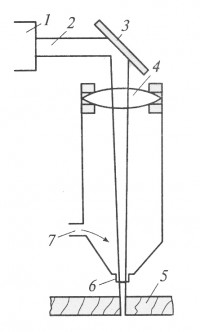
Thus, if you look at the scheme, you can note that the section of the workpiece in its cross section has a conical shape. Those. the faces of the parts are not perpendicular to the surfaces, but are inclined and form a trapezoid. To make it clearer, imagine a round vertical hole in a sheet of plywood, laser-cut around the perimeter. So, the diameter of the hole on the upper side of the sheet will be slightly larger than the bottom. The material (wood) burns from top to bottom, and at the top it burns out more, because in the upper layers the laser beam stays longer in time and transmits more heat to the surrounding material.
Consequently, all printer parts have an irregular shape in cross section, which must be taken into account when assembling “sandwiches”, i.e. when pieces of plywood lie on top of each other, especially with through holes.
Studio Tips (C)
Be prepared that the details for your printer were cut to the worst Chinese machine and no dimensions will be as stated in principle. To achieve this result is relatively easy, even on a good machine. It is enough just to cut the contour of the part at the beginning, and only then cut the grooves and holes in the loose part. Plywood is a material that “floats” when cutting due to internal stresses in glued perpendicular layers. Therefore, if you first cut the contour, then the part is slightly shifted, losing communication with the mother-workpiece. A similar effect is observed even if the perimeter is not completely cut, leaving small adhesions to the outer contour.
Exact detail will be obtained only if all the holes and grooves were first cut into the workpiece, and only then the workpiece was cut into final parts. PB - this is not the case, accept and stock up with a sharp knife, file and skin.
Examples of blanks PB
one
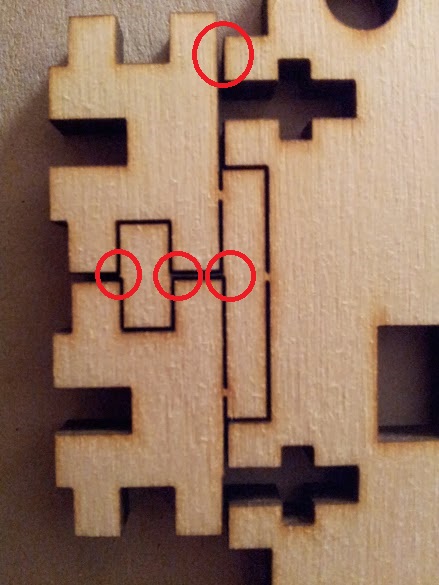
2

3
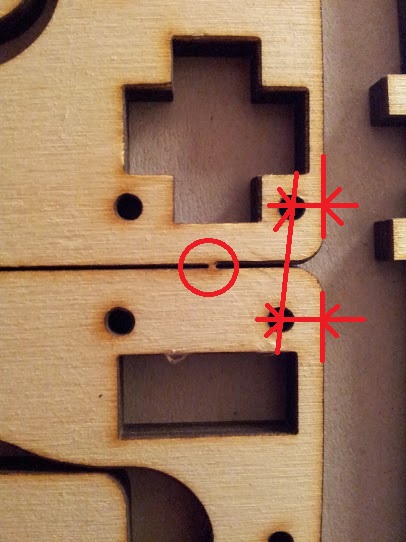
And the amount of waste after processing the first half of the parts.
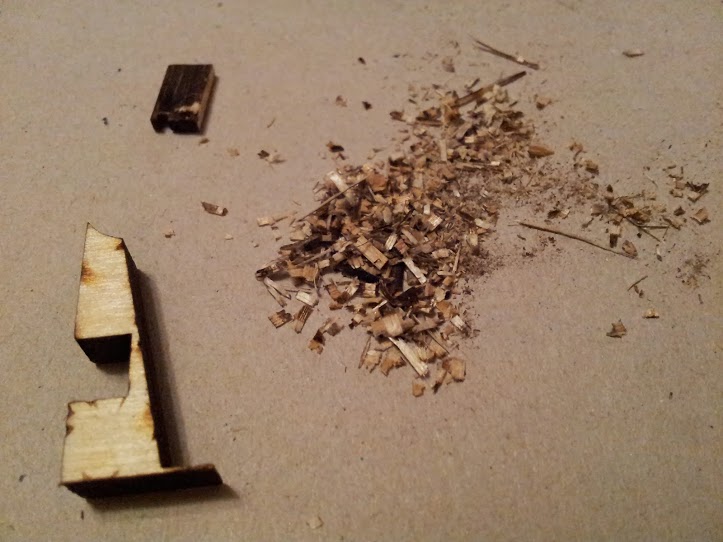
Now directly about the assembly of "sandwiches."
Sandwiches in the bulk should be collected mirror. Those. larger diameters with larger, smaller with smaller.
If the same symmetrical parts are located at different ends of the printer or axes, it is also mirrored. Otherwise, lose alignment.
The exceptions are the same, but the parts are not made of mirror (I came across a pair of these at the base of the printer). Those. those parts that are the same and are installed on the printer symmetrically, the walls of the box base, for example, but on the workpiece they were located and sawed out not mirrored ... not upside down ... well, you understand - in this case, the parts should be put just in sequence, otherwise , again, the alignment will be broken and the “box” will become a curve and the following parts will no longer exactly fall into each other's grooves. You will be tormented, but they still will not fall. And the box you can not disassemble - it is glued. Are you all carefully taped? Here it is. In this case, save only redundant parts.
Parts with holes should be worn on the axle with exceptionally smaller diameters. Moreover, if you put on a sandwich, then you should prepare it with large diameters for larger diameters, respectively. This will give greater rigidity.
All openings are recommended to go through with a drill of the appropriate diameter, manually, one or two turns, not more! The fact is that after laser cutting the edges of the parts and holes are covered with a carbon layer, which is an excellent wood protection in case of rubbing parts (extruder gears). Therefore, to remove this layer is strictly not recommended, even with dirty hands. Additionally, for light plywood, the black contour adds aesthetic beauty.
On the other hand, the carbon layer somewhat changes the size of the part, which in the case of holes reduces the diameter. You can certainly take into account the error in size in the cutting process, but the coal layer is not eternal and easily crumbling. As a result, again you will lose in size, the axis will begin to stagger. It is best to go a couple of times with a drill and fit it on an axle. And do not forget to drop glue.
Information that the holes and parts have a different diameter and size from the outside and inside, pops up in the instructions right near the end of the second third, when you have already assembled a large part of the printer incorrectly.
One more thing. American products have half the size - inch. In my particular case, the inches were all screws and nuts, including the threads on the guides. Holes were metric, under 8mm.
The heads were bolted, in half of the cases were cross-shaped, and in half on the inner sprocket of a very small size. Get a set of small stars better in advance.
Very useful advice: glue everything that you can glue. PVA for in this case fits perfectly. It perfectly glues plywood, fills the voids and even manages to fall on the fat, oiled axles, forming a solid crust and preventing play and unbalance.
PVA glue is really well diluted with oil, it does not spoil it. This effect is applied by artists when PVA is added to oil paints for better coupling and adhesion.
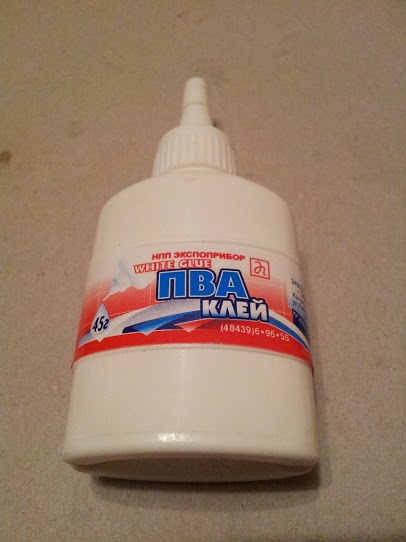
Edging with a sharp knife, if necessary, is preferable to skin or file. Less dirt.
Before processing wooden parts it is recommended to paint everything at once by impregnation for wood. This will give a unique color to your printer and will connect the carbon layer on the edges. Plywood will not crack during operation and will not get dirty anymore. Impregnated edges will be less prone to chipping, especially on the gear teeth.
I got the first version of PB Jr v1. This version uses two wooden gears in the extruder.
One on the motor shaft, glued in four parts. A

nut is pressed into the inside of the two smooth rings on the leg, into which a stop screw will be screwed in through a hole in the right side.

The second, large, is assembled from two parts and sits on the shaft of the ribbed bolt, which
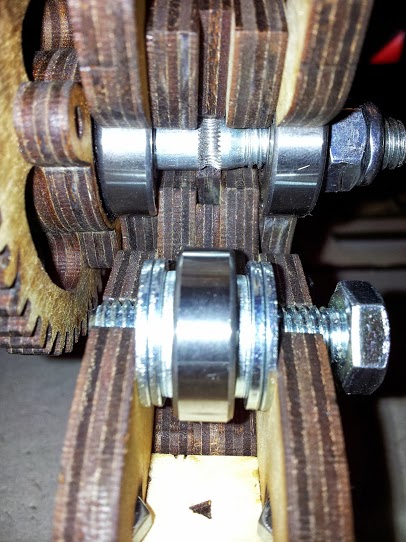
pulls the bar so that the large gear does not rub inside with the bearing, it is recommended to make a shallow 1 mm groove under the diameter of the outer ring of the bearing.

For these purposes, a home burner is ideal, for one childhood and remember, and show the child.
As a result, the load on the gear pair will be significantly reduced, which will significantly increase the resource of the extruder and especially the gear itself.
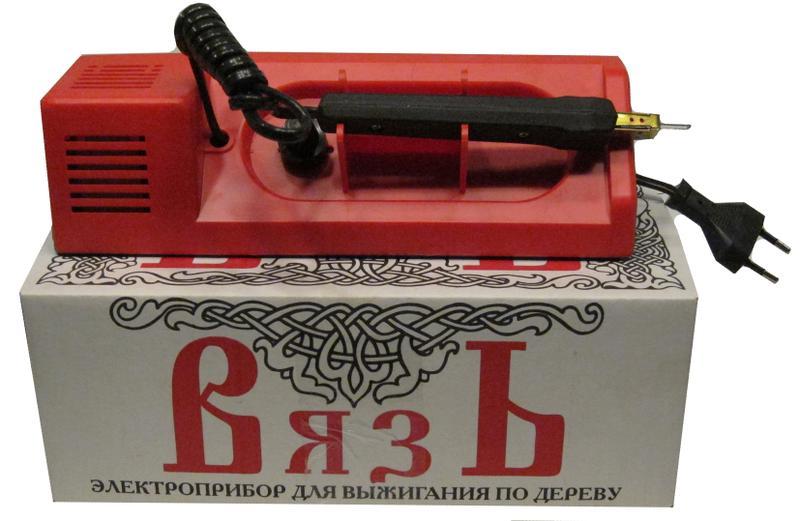
In the future, when mastering high-resolution printing, I recommend, without delay, printing a few sets of plastic gears, you can from PLA. They will last longer and print accuracy will increase.

You can choose a model to taste here , but I recommend it with oblique teeth.
If you can’t refuse the captivating beauty of the wooden gear mechanism that happened to the author, then I recommend immediately after the installation process the gears with WD oil and periodically repeat this procedure. Do not worry, the plywood will not be unglued, but it will swell just enough to eliminate the slightest play in the pair. In addition, the oily edges of the large gear will sever more significantly.
With a big gear there is another nuance. In earlier models, it was glued together from two parts of plywood, and the thickness was the same as the small gear. In later models, the large gear became single, and due to the increased load on the area of the tooth, it began to wear out faster, not smeared teeth simply split in front of their eyes.
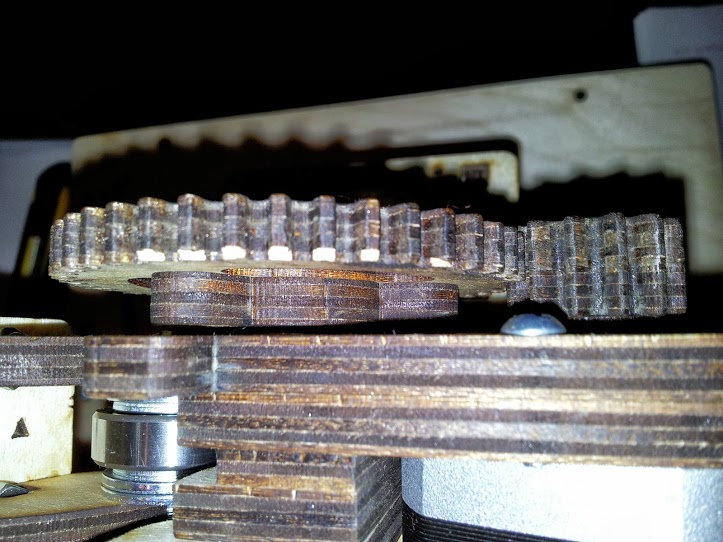
And one more nuance. Large single gear is positioned relatively small not in the middle, but with an offset to the outer edge of the small gear. In this case, in no case do not glue the small gear with small diameters inwards, only outwards! This will take the maximum load on the large gear tooth from the outer edge closer to the middle.
Doroy Reader!
Starting with the gears, I smoothly moved from the introductory part directly to the assembly of printer parts. However, the volume of photographic materials and text advises me to interrupt, so that this reading does not cause you to reject prematurely.
In the next article, and this will be the continuation of the second part, I will try to complete the assembly of the printer, carry out calibration and begin practical use.

FOREWORD
Printrbot'y (hereinafter PB) - rare guests on Habré, and indeed, in the press about them write a little.
Although the Brook Drumm affair (Brook Drumm) lives and thrives in its homeland.
I suppose what the printer pushes away the European dealers, so he drew me, namely:
- Plywood performance is stylish. Plywood laser cutting is not only stylish, but also high-tech.
- No casing box. I see the printer, its parts, its organs, its movements, and unlike RepRap Prusa Mendel - I like what I see.
Next, we will discuss one of the representatives of the PB - Printrbot Jr , in Kit's version for assembly, together with an additional desktop upgrade with heating - Heated Bed Upgrade , for printing with ABS plastic.
Now this printer has been purchased, assembled, calibrated and is working hard on my desk, printing toys for the New Year.
I want to describe the fate of this exhibit from the very beginnings, from the very idea to its immediate application, since this fate was not easy and closely intertwined with mine, sometimes first leading to complete psychological exhaustion, and then sharply stunning the Wow effect.
Initially, three parts were conceived: From the idea to the acquisition of Kit; Assembly and setup of the printer; From toys to practical use. But in the process of writing, I decided to include everything in one article with an emphasis on assembly and configuration.
As a result, I recommend this material as an extremely useful addition to the original and only step-by-step assembly instruction , which is extremely superficial, ambiguous and leaves much to be desired.
Looking ahead, I’ll say that this 3D printer was worth the trouble), which distinguishes it from many of its fellows, and more on that in order.
Part 1
Muse Isaakovna
The more articles about household-home 3D printers, the more I wanted to buy one. But the price is from 50-60 tr. did not allow the dream to come true, since the investments in the toy were obviously overstated. Why in a toy? Because even now the practical application of a home-based 3D printer is not very clear. But about this, too, a little later.
')
The RepRap project, for which Muse Isaakovna organized close monitoring, was and remains a panacea that allows any technically savvy amateur to assemble their own 3D printer at a more or less reasonable price and quite acceptable quality. Accuracy of the press 0.1 mm provides practically any household needs. But watching the development of the project all the time there was a feeling of some kind of dampness of the structure ... until independent directions began to sprout from the project. Departing from the ideology of true RepRap, which, if possible, prints most of the details for itself, new projects began to take the best practices of RepRap and discard imperfect self-printed designs, which were replaced by similar ones, but from a different material or fundamentally new ones.
So MakerBot and many of its clones "in the box" appeared. The era of monetization of 3D printers and consumer 3D printing has begun. But the price for the final product was still too high, especially for a housewife and with still not quite specific formulation of home use. It was necessary to simplify.
And so Cube appeared, and naturally its “followers” . And they came cartridges! The main source of earnings for printer manufacturers. To close the uncertainty with the use of steel began to create a database of 3D-models .
"And everything seems to be as usual, and it seems like to live, do not hurt."
But the price ... 500-700 USD, it still was not something that I would like to spend on a toy for the soul. And again, how to explain such expenses to the wife ...
Muse Isaakov frowned unpleasantly but continued to demand to remind herself of herself.
You ask then, why not put together the original RepRap, if you really want to? I will answer once again - for a shrewd design engineer, all RepRap models are literally teeming with controversial and not quite effective technical solutions. I will emphasize - namely, technical solutions, i.e. the design of the truss, drives, extruder, etc. Because I have no complaints about any electronic circuit board of brains and firmware, this is a controller for 4-5 step motors, three limit switches, 1-2 heaters and 1-2 thermistors, understanding G -code. This is all about the same and is based on the Arduino. And the software part is able to withstand accuracy and 0.01 mm, but is the hardware capable? Is the mechanic able to provide the specified accuracy and smoothness of movements?
The classic RepRap'a is not exactly in trouble, but due to the triangular-square truss from round axes in plastic brackets, even if it is reinforced with a U-shaped truss in recent versions ... well, it’s not aesthetically pleasing. Not a lunar rover. "Saw Fedya, saw!" (C)
The bottom line: RepRap is a fine, but experimental laboratory; 3D printers a la MakerBot - still indecent road; UP! Plus and others like Cube with them - they print thickly and tend to original cartridges! which my inner self does not accept genetically, and even in the presence of several successful projects of mini-factories for the production of recycled bars.
But here flashed in the press Printrbot.
And on Habré flashed .
Here I want to immediately make a reservation that this is not PR or advertising. This is a story about a printer that is fundamentally unlike all others. Hence to him my tremulous love and attention. And as a result, the printer showed itself from the best side and met the expectations that had been placed, though it was traumatic and psychologically traumatic several times. And this is a tribute to the deep respect for the talents of Brooke Drumm, who has an outstanding appearance and dedication, who turned his hobby into a successful business. Which formulated his concept of home 3D-printer, which coincides with the opinion of the author, and relentlessly follows it.

Brooke Drumm with his creations.
Plywood ... wood in 3D printing! It was a steampunk, or woodpunk, I don’t know what’s best.
The live Soviet coat of arms is quick, like a blow with a hammer, and sharp, like a sickle in the balls. (WITH)
After close examination, the following were noted:
- The original design of the Z-axis with one motor (in Junior and Simpl).
- The original design of plywood laser cutting.
- The original construction as a whole, rigid, devoid of visible flaws (with the exception of wood, which is not characterized by precision stiffness, but more on that later).
- Availability of kits for self-assembly.
- The declared accuracy is 0.1 mm.
- The original ceramic hot end (Ubis Ceramic Hot End) , developed by a specialist in printers, an engineer from HP - Carl Ubis.
- Price!
But that moment the Junior Whale Set cost 399 USD on the manufacturer's website. After the appearance of the Simple whale for 299 USD, the junior whale was, unfortunately, removed from production.
Muse Isaakov stared from the reflection of the monitor, straightened the cardigan, pressed the massive chest in Raikin's and exhaled - We must take it!
I said - I obey! - and ran to the Internet.
This is my uncle sent ... He lives at the watchmaker's factory at the watchman ... He has this shoe polish - well, just damn it! .. So he sends, hmmm ... to anyone ...
It was not so easy to write “shoe polish” from the American “uncle”. Rather, there were no problems with the ordering, even to a Moscow address, but with payment ...
Printrbot turned out to be a small company, frankly home. And its not less small, unknown bank at the border of the United States and Canada flatly refused to accept payment from a citizen of the Russian Federation. He refused to accept from the ruble account, from the currency account and even from the PayPal resident of the Russian Federation. The latter introduced in some stupor, since when did PayPal become sensitive to citizenship ?! But Musa Isaakovna was the only attendeer of heart issues, but she was silent, and only demandingly and intently allowed mental fluids.
Next, I planned to devote a separate part of the article to the method of purchases from the states. But, having a keen desire to quickly move on to the assembly, I will limit myself to a brief summary, especially on the very topic of such purchases written and so much and in individual articles.
As a result, the following combination was played.
Registered account in Shipito .
Pre-paid photos of the contents of parcels in face, profile and in parts.
The address of the “transit point” in the United States in the duty-free zone is selected: Tualatin, Oregon .
All possible supporting documents were sent to improve the status of the account, in order to avoid problems and delays in payment and sending parcels:
- passport scan;
- driver's license scan;
- scan utility bills;
- scan form 1583 with your signature.
All this was enough to get the status of checking 70% and enter the green zone of trusted-trusted clients.
If you additionally send the form 1583 in the original and notarized, you will have 110% verification, yellow pants and three times Ku!
Further, the Tualatin city was specified on the PB website at the delivery address, which is in the state of Oregon and ... And payment from the ruble card through PayPal went smoothly.
After a couple of days, the package arrived in Tualatin, and a dozen of pretty photos appeared in Shipito’s personal account.
Some of them:
one

2

3

four

five

6

7

At the insistence of the Shipito website, I had already filled out the customs declaration before the parcel arrived, honestly listing all items and prices, on the basis of an invoice from the PB shop. The parcel status was assigned, of course, Gift - a gift, that is, not for resale. The delivery address in Moscow was also entered in the personal account and selected for default deliveries.
On the recommendation of this article , the delivery method and the insurance options for it were chosen:
USPS Express Mail
Insurance: Delivery + Damage
As shown, in no case do not save on shipping and insurance, within reasonable limits of course. With the chosen method of delivery, the parcel was handed from hand to hand, in a pre-agreed time interval, by a very, very tidy courier EMS Russian Post. The truth is not on time ...
As a result, it only remains for me to confirm the quality of the photos and the contents, confirm the delivery method, transfer the amount necessary for the calculation to the Shipito account, and the printer immediately went to the previously entered address.
To Moscow, comrades, to Moscow! (WITH)
Immediately after the shipment from Shipito, the parcel was assigned an ID-number tracker by which the fate of the shipment could be tracked on the USPS website until it entered the EMS.
A week later, the cargo had already arrived in Russia, lay for a couple of days at customs, was missed and disappeared into the EMS.
A month later, a very polite operator called me and agreed on the time and place of delivery of the precious cargo. And, as I wrote earlier, the cargo was delivered intact, “on time” and passed from hand to hand with a dazzling smile.
Muse Isaakovna exulted.
Part 2
Assembly technology and testing of accelerating units for heavy carrier rockets
About a month has passed from the moment I received the parcel before I started assembling the dream unit.
During this time, Musa Isaakovna managed to gain a few extra pounds, ring out in breadth and noticeably rounded, and I managed to acquire some additional tools for assembly, such as a ratchet clamp, a mallet, PVA glue, and a wood burner.
And now the hour X has come. The instructions from the site were printed, the box was opened and the process began.
As I said earlier, this material is a useful addition to the main printer assembly instructions.
And there is.
And before the next follower starts to assemble the wonderful Printrbot Jr on his own, I will give some background information, which it is extremely useful to learn without fail before starting the assembly, in order to understand and understand exactly what you received in the cherished box. This will help protect you from a lot of annoying blunders that the author tragically experienced.
So let's start with plywood laser cutting.
To understand the essence of the problem you need to refer to the device of the laser cutting machine.
In essence, this is the same coordinate printer, only instead of an extruder - a laser cutter. More precisely, the CO2 laser lamp is located somewhere immobile in a protective casing, and the laser beam itself is focused by a lens and transmitted to the treated surface by a system of movable mirrors.
Schematic diagram of a laser cutting machine

The scheme of the laser machine for cutting sheet wood materials

- gas laser (active substance CO2);
- beam of rays;
- mirror system;
- lens system;
- harvesting;
- nozzle;
- nozzle for inert gas.
Thus, if you look at the scheme, you can note that the section of the workpiece in its cross section has a conical shape. Those. the faces of the parts are not perpendicular to the surfaces, but are inclined and form a trapezoid. To make it clearer, imagine a round vertical hole in a sheet of plywood, laser-cut around the perimeter. So, the diameter of the hole on the upper side of the sheet will be slightly larger than the bottom. The material (wood) burns from top to bottom, and at the top it burns out more, because in the upper layers the laser beam stays longer in time and transmits more heat to the surrounding material.
Consequently, all printer parts have an irregular shape in cross section, which must be taken into account when assembling “sandwiches”, i.e. when pieces of plywood lie on top of each other, especially with through holes.
Studio Tips (C)
Be prepared that the details for your printer were cut to the worst Chinese machine and no dimensions will be as stated in principle. To achieve this result is relatively easy, even on a good machine. It is enough just to cut the contour of the part at the beginning, and only then cut the grooves and holes in the loose part. Plywood is a material that “floats” when cutting due to internal stresses in glued perpendicular layers. Therefore, if you first cut the contour, then the part is slightly shifted, losing communication with the mother-workpiece. A similar effect is observed even if the perimeter is not completely cut, leaving small adhesions to the outer contour.
Exact detail will be obtained only if all the holes and grooves were first cut into the workpiece, and only then the workpiece was cut into final parts. PB - this is not the case, accept and stock up with a sharp knife, file and skin.
Examples of blanks PB
one

2

3

And the amount of waste after processing the first half of the parts.

Now directly about the assembly of "sandwiches."
Sandwiches in the bulk should be collected mirror. Those. larger diameters with larger, smaller with smaller.
If the same symmetrical parts are located at different ends of the printer or axes, it is also mirrored. Otherwise, lose alignment.
The exceptions are the same, but the parts are not made of mirror (I came across a pair of these at the base of the printer). Those. those parts that are the same and are installed on the printer symmetrically, the walls of the box base, for example, but on the workpiece they were located and sawed out not mirrored ... not upside down ... well, you understand - in this case, the parts should be put just in sequence, otherwise , again, the alignment will be broken and the “box” will become a curve and the following parts will no longer exactly fall into each other's grooves. You will be tormented, but they still will not fall. And the box you can not disassemble - it is glued. Are you all carefully taped? Here it is. In this case, save only redundant parts.
Parts with holes should be worn on the axle with exceptionally smaller diameters. Moreover, if you put on a sandwich, then you should prepare it with large diameters for larger diameters, respectively. This will give greater rigidity.
All openings are recommended to go through with a drill of the appropriate diameter, manually, one or two turns, not more! The fact is that after laser cutting the edges of the parts and holes are covered with a carbon layer, which is an excellent wood protection in case of rubbing parts (extruder gears). Therefore, to remove this layer is strictly not recommended, even with dirty hands. Additionally, for light plywood, the black contour adds aesthetic beauty.
On the other hand, the carbon layer somewhat changes the size of the part, which in the case of holes reduces the diameter. You can certainly take into account the error in size in the cutting process, but the coal layer is not eternal and easily crumbling. As a result, again you will lose in size, the axis will begin to stagger. It is best to go a couple of times with a drill and fit it on an axle. And do not forget to drop glue.
By the way
Information that the holes and parts have a different diameter and size from the outside and inside, pops up in the instructions right near the end of the second third, when you have already assembled a large part of the printer incorrectly.
One more thing. American products have half the size - inch. In my particular case, the inches were all screws and nuts, including the threads on the guides. Holes were metric, under 8mm.
The heads were bolted, in half of the cases were cross-shaped, and in half on the inner sprocket of a very small size. Get a set of small stars better in advance.
Very useful advice: glue everything that you can glue. PVA for in this case fits perfectly. It perfectly glues plywood, fills the voids and even manages to fall on the fat, oiled axles, forming a solid crust and preventing play and unbalance.
By the way
PVA glue is really well diluted with oil, it does not spoil it. This effect is applied by artists when PVA is added to oil paints for better coupling and adhesion.

Edging with a sharp knife, if necessary, is preferable to skin or file. Less dirt.
Before processing wooden parts it is recommended to paint everything at once by impregnation for wood. This will give a unique color to your printer and will connect the carbon layer on the edges. Plywood will not crack during operation and will not get dirty anymore. Impregnated edges will be less prone to chipping, especially on the gear teeth.
Pro gears
I got the first version of PB Jr v1. This version uses two wooden gears in the extruder.
One on the motor shaft, glued in four parts. A

nut is pressed into the inside of the two smooth rings on the leg, into which a stop screw will be screwed in through a hole in the right side.

The second, large, is assembled from two parts and sits on the shaft of the ribbed bolt, which

pulls the bar so that the large gear does not rub inside with the bearing, it is recommended to make a shallow 1 mm groove under the diameter of the outer ring of the bearing.

For these purposes, a home burner is ideal, for one childhood and remember, and show the child.
As a result, the load on the gear pair will be significantly reduced, which will significantly increase the resource of the extruder and especially the gear itself.

In the future, when mastering high-resolution printing, I recommend, without delay, printing a few sets of plastic gears, you can from PLA. They will last longer and print accuracy will increase.

You can choose a model to taste here , but I recommend it with oblique teeth.
If you can’t refuse the captivating beauty of the wooden gear mechanism that happened to the author, then I recommend immediately after the installation process the gears with WD oil and periodically repeat this procedure. Do not worry, the plywood will not be unglued, but it will swell just enough to eliminate the slightest play in the pair. In addition, the oily edges of the large gear will sever more significantly.
With a big gear there is another nuance. In earlier models, it was glued together from two parts of plywood, and the thickness was the same as the small gear. In later models, the large gear became single, and due to the increased load on the area of the tooth, it began to wear out faster, not smeared teeth simply split in front of their eyes.

And one more nuance. Large single gear is positioned relatively small not in the middle, but with an offset to the outer edge of the small gear. In this case, in no case do not glue the small gear with small diameters inwards, only outwards! This will take the maximum load on the large gear tooth from the outer edge closer to the middle.
Break
Doroy Reader!
Starting with the gears, I smoothly moved from the introductory part directly to the assembly of printer parts. However, the volume of photographic materials and text advises me to interrupt, so that this reading does not cause you to reject prematurely.
In the next article, and this will be the continuation of the second part, I will try to complete the assembly of the printer, carry out calibration and begin practical use.
Source: https://habr.com/ru/post/195980/
All Articles